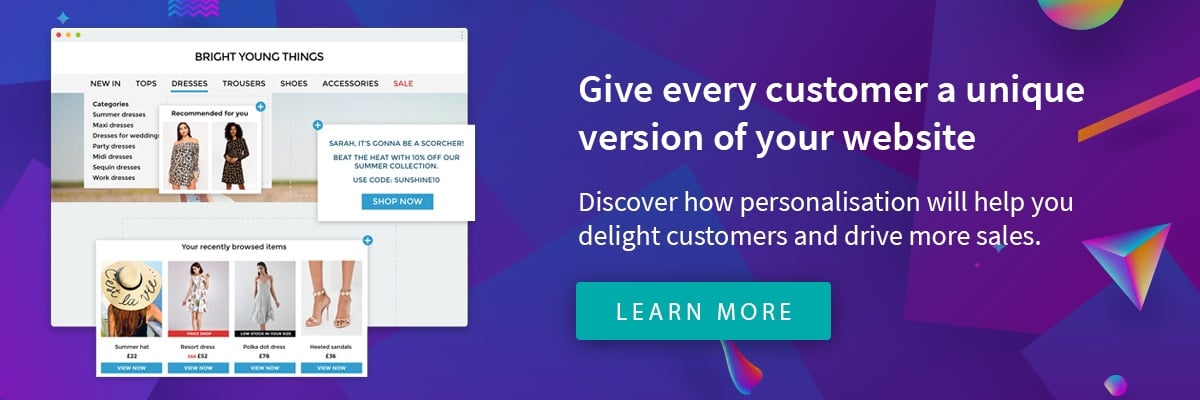Product recommendations are not just nice to have.
They generate traffic, increase order values, and—most importantly—boost sales. All reasons why they’re an essential feature of the world’s most popular eCommerce sites.
Using product recommendations can be as simple as featuring bestsellers on email. Or, as far-reaching as curating your entire website around the visitor’s past shopping habits.
In this blog post, we take a look at how the most successful retailers use product recommendations to increase sales.
Timely recommendations
According to McKinsay, 30 percent of Amazon’s traffic comes from recipients clicking on personal recommendations.
This isn’t simply because the products it features match the recipient’s previous purchases. Amazon profiles its entire customer database so it can make suggestions based on what similar people chose to view and buy.
In very simple terms, product recommendations allow you to put the right products in front of the right people at the right time.
As savvy marketers are increasingly using automations to manage their email programs, these recommendations can be integrated into email. They can be sent the moment someone leaves a site—when they are most receptive to your suggestion.
We like this example of a well-timed automation sent by Amazon. It features product recommendations based on what’s just been browsed onsite.
Personalising the shopping experience
Rejoiner estimates that Amazon dedicates a whopping 70 percent of its homepage to product recommendations. This means that every shopper gets a completely personal shopping experience as soon as they land on the site.
If you’re a first-time visitor, Amazon will show you generic product recommendations. These feature crowdsourced bestsellers, or what other customers are looking at right now.
Once you’ve shopped, you’ll start to see a more personalised storefront suggesting complementary purchases matched to your latest order or browsing history.
With each visit, machine learning means Amazon becomes more adept at presenting exactly what you’re looking for—without you having to search for it.
Amazon’s homepage becomes a storefront dedicated to you, so you find what you need faster (which, in turn, increases its conversion rate).
Improving customer journeys
If you’re a savvy retailer, you don’t just leave your customer’s journey to chance.
Once they’ve clicked on a product recommendation, you’ll want to show them both complementary and alternative items. This could be other products that people browsed after looking at this one, or recommendations for products frequently purchased with it.
These tactics encourage visitors to explore. They improve user journeys by cleverly linking the products through further recommendations.
This means you’re not reliant on people stumbling on your products. You can display your whole range from just one click.
We love how Amazon puts new items on our radar by showing us what other people who bought this product also purchased. It’s a clever use of social proof to influence our purchasing decisions, and showcase more products in the range.
Adding more items to the cart
When the shopper has added a product to their cart, it’s time to build the value of their order with additional product recommendations.
Most often these are suggestions of complementary purchases designed to cross-sell or upsell. Items that ‘complete a look’, for example.
The product recommendations presented at the basket page are much like the sweets at the supermarket checkout. They’re relatively low cost, tempting items that are easy to add to a shop without thinking too much.
Whatever product recommendations you show as your customer is about to complete their purchase, your aim should be to increase the number of items the shopper will leave with.
Amazon is increasingly ‘bundling’ its items. It doesn’t just show product recommendations, but suggestions for entire orders based on what other customers purchased alongside the product.
Referring friends
Just because someone has purchased something, this doesn’t mean that you should stop thinking about recommendations.
Now is the time to ask them to share the news of their purchase with friends. You can do this through an automated post on social media. Hearing a trusted friend talking about something they’ve just bought makes people far more likely to buy from the same brand.
At this stage of the purchase process, product recommendations should be used as referral tools. Asking people to share their purchases with others helps generate traffic and more sales.
Amazon wastes no time, making it easy for its customers to share their latest purchase on social media directly from the order confirmation page!
Takeaway
It’s clear to see that product recommendations drive commercial results. They’re an easy tactic to integrate throughout your entire eCommerce setup. And they can deliver a unique shopping experience to every recipient and visitor.
The best news of all is the more your customer engages with product recommendations, the more you’ll learn about them.
Each visit and click allows you to refine what you display, making it more accurate and more relevant. This increases traffic, engagement, and conversion rates.
So, if you’re looking at how to increase sales in 2018, product recommendations could be a real game-changer. One which will let you get the right products, to the right people, at exactly the right time.






